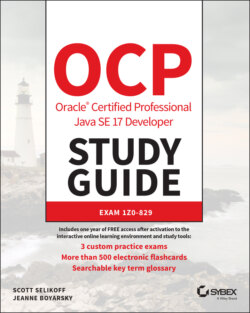Читать книгу OCP Oracle Certified Professional Java SE 17 Developer Study Guide - Jeanne Boyarsky - Страница 66
Classes and Source Files
ОглавлениеMost of the time, each Java class is defined in its own .java file. In this chapter, the only top-level type is a class. A top-level type is a data structure that can be defined independently within a source file. For the majority of the book, we work with classes as the top-level type, but in Chapter 7, “Beyond Classes,” we present other top-level types, as well as nested types.
A top-level class is often public, which means any code can call it. Interestingly, Java does not require that the type be public. For example, this class is just fine:
1: class Animal { 2: String name; 3: }
You can even put two types in the same file. When you do so, at most one of the top-level types in the file is allowed to be public. That means a file containing the following is also fine:
1: public class Animal { 2: private String name; 3: } 4: class Animal2 {}
If you do have a public type, it needs to match the filename. The declaration public class Animal2 would not compile in a file named Animal.java. In Chapter 5, “Methods,” we discuss what access options are available other than public.
Noticing a pattern yet? This chapter includes numerous references to topics that we go into in more detail in later chapters. If you're an experienced Java developer, you'll notice we keep a lot of the examples and rules simple in this chapter. Don't worry; we have the rest of the book to present more rules and complicated edge cases!
